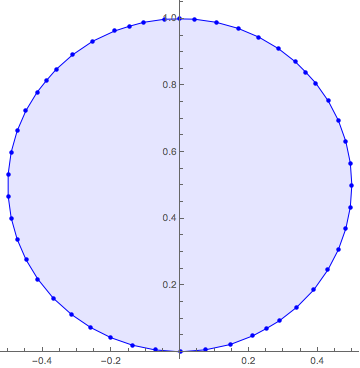Find the Largest Small Polygon
Find the polygon with maximal area among polygons with  sides and diameter
sides and diameter  .
.
In Mathematica 11, FindMinimum adds an IPOPT solver to solve large-scale constrained optimization problems more efficiently.

Denote by n the number of vertices of the polygon.
In[1]:=
n = 50;Let  be the polar coordinates of the
be the polar coordinates of the 
![]() vertex of the polygon.
vertex of the polygon.
In[2]:=
vars = Join[Array[r, n], Array[\[Theta], n]];They satisfy the constraints  ,
,  ,
,  ,
,  .
.
In[3]:=
varbounds =
Join[Table[0 <= r[i] <= 1, {i, n - 1}], {r[n] == 0},
Table[0 <= \[Theta][i] <= Pi, {i, n - 1}], {\[Theta][n] == Pi}];The area of the polygon is the sum of the areas of triangles with vertices  ,
,  , and
, and  (the origin).
(the origin).
In[4]:=
area = 1/2 Sum[
r[i] r[i + 1] Sin[\[Theta][i + 1] - \[Theta][i]], {i, 1, n - 1}];The distance between every two vertices should not exceed 1.
In[5]:=
constr1 =
Flatten[Table[
0 < r[i]^2 + r[j]^2 -
2 r[i] r[j] Cos[\[Theta][i] - \[Theta][j]] <= 1, {i, 1,
n - 1}, {j, i + 1, n}], 2];Due to the vertex ordering, the following constraints also exist.
In[6]:=
constr2 = Table[\[Theta][i] <= \[Theta][i + 1], {i, 1, n - 1}];Choose initial points for the variables.
In[7]:=
x0 = vars /. {r[i_] ->
4. i (n + 1 - i)/(n + 1)^2, \[Theta][i_] -> \[Pi] i/n};Maximize the area subject to the constraints.
In[8]:=
sol = FindMaximum[{area, constr1, constr2, varbounds},
Thread[{vars, x0}]];Convert to Cartesian coordinates.
In[9]:=
rectpts =
Table[FromPolarCoordinates[{r[i], \[Theta][i]}], {i, 1, n}] /.
sol[[2]];Plot the solution.
In[10]:=

Show[ListPlot[rectpts, PlotStyle -> {Blue, PointSize -> Medium}],
Graphics[{Opacity[.1], Blue, EdgeForm[Blue], Polygon[rectpts]}],
AspectRatio -> 1, ImageSize -> Medium]Out[10]=
































